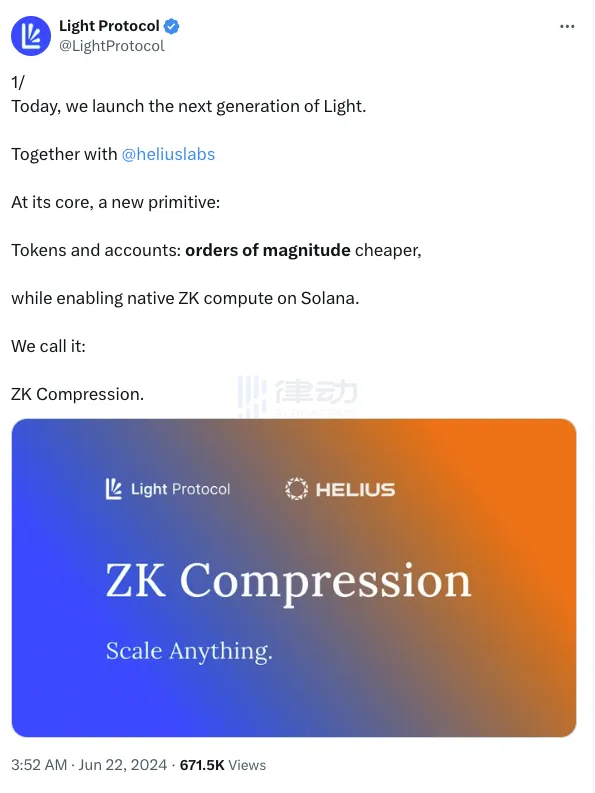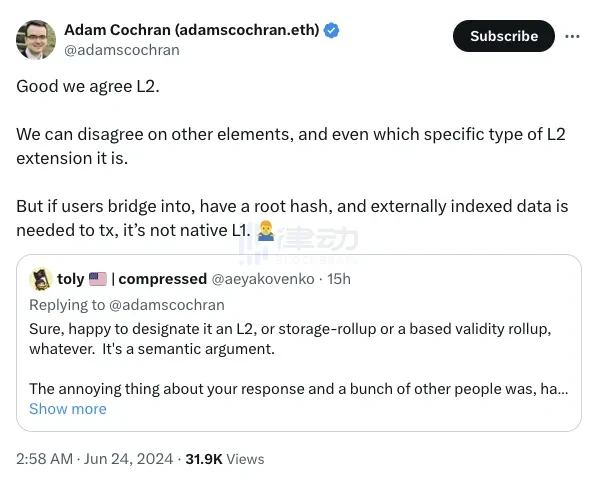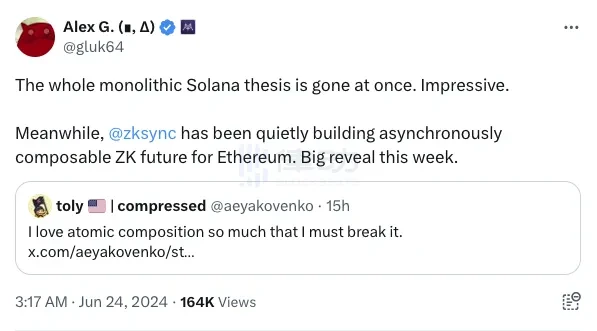Solana launches ZK Compression, has the Ethereum community been broken?
Solana and the Ethereum community are arguing again, this time over Solana’s newly launched ZK Compression technology.
Yesterday, Mert Mumtaz, CEO of Solana ecosystem development platform Helius, announced on the X platform that ZK Compression is being introduced to Solana. Soon after, Solana ecosystem privacy project Light Protocol announced the launch of ZK Compression. According to Mert, ZK Compression will be performed directly on L1 without L2, which will greatly improve the scalability of the Solana network, and take a step towards building a financial computer – an unstoppable, global, atomic state machine synchronized at the speed of light.
According to the ZK Compression documentation , the technology is a new primitive built on Solana that enables developers to build applications at scale. Developers and users can choose to compress their on-chain states, reducing state costs by orders of magnitude while maintaining the security, performance, and composability of Solana L1.
ZK Compression works through a process called state compression, allowing developers to use Solanas cheaper ledger space instead of more expensive account space to store certain types of data. Hashes or fingerprints of off-chain data are stored on-chain for verification using sparse state trees.
Is the Ethereum community broken?
A purely technical explanation may be too complicated, but to put it simply, this technology reduces Solana’s state cost.
In Solana, technicians face two costs – computational cost and state cost. Solana currently has cheap computing power, but state is expensive. Allocating accounts, paying rent, and scaling with users have proven to be huge obstacles for Solana developers, and ZK Compression solves this problem.
Mert used the cost of airdrops as an example, assuming that airdrops were made to 1,000,000 users, the state cost would be reduced from over $260,000 to $50, which is 5,200 times cheaper. Justin Bons, founder and CIO of Cyber Capital, also believes that ZK Compression clearly puts Solana far ahead of ETH in terms of actual L1 scalability, solving one of Solanas biggest survival problems.
The views expressed by Justin Bons made the Ethereum community, which was trapped in the expansion problem and turned to rollup, uneasy. They questioned the L1 nature of ZK Compression.
Since Mert said that ZK Compression data is kept off-chain, the Ethereum community regards it as validium. The Solana community responded with a meme, mocking that they claim to be experts without doing serious research. Mert even named ZK Compression ZK validium out of spite.
In order to convince the Ethereum community, Mert named Ethereum founder Vitalik on Farcaster and asked him to comment on the technical principles of ZK Compression. Vitalik also responded seriously and said that the technology is more like a stateless client architecture.
Vitalik interprets ZK Compression into 3 main points. First, you have a new class of accounts, for which only the hash of their state is stored on the chain. Second, to interact with these accounts, you need to write a TX that specifies the pre-state hash and post-state hash of N accounts and provides a validity proof (assuming this means ZK-SNARK). Third, the new state is required to be public (which makes sense, otherwise you can randomly send someone a sum of money and their account will be inaccessible. You can get around this and make it a Ut xo system, but that would be a significant limitation).
In addition to the interpretation, Vitalik also raised questions about the document. On the one hand, it was the 128-byte validity proof mentioned in the document, and on the other hand, it was whether the public content included transaction content.
Later, Vitalik expressed his doubts again. He thought that the figures claimed by ZK Compression were like that if done separately each time, the cost of verifying SNARK would be higher than the cost of doing some small actions and hash operations (such as token transfers). The benefits of ZK rollup come from one SNARK packaging many transactions.
But Vitaliks question was not answered, and his initial description of ZK Compression as a stateless client architecture gave supporters including Mert more confidence.
CEHV partner Adam Cochran firmly stated that ZK Compression is Solanas L2 solution, and he believes that one day, the Solana crowd will realize that what they have built is a good rollup based on L2 functionality/validity, not a whole chain. Adams firm attitude also attracted criticism from Mert.
Solana co-founder Anatoly Yakovenko seemed to be “indifferent” to the L1 or L2 debate, and even said that he was “happy to designate it as L2, storage rollup, or validity-based rollup, etc.” He just emphasized that “all executions occur on L1 and are ordered by L1 validators.” Although Adam was different from Mert’s tough response, he still insisted that ZK Compression could not be L1.
Alex Gluchowski, founder of ZKsync, was also critical of ZK Compression. At the same time, he said that ZKsync has been quietly building an asynchronous and composable ZK future for Ethereum. But interestingly, after the release of ZK Compression, Anatoly also published a long article introducing asynchronous program execution (APE) in Solana.
Will Rollup be the perfect match for Solana?
Solana has been looking for value for its network. The valuation logic of the altchains that emerged from the last bull market is not exactly like Bitcoin and Ethereum. Due to the cheap block space, it is difficult for the corresponding coin prices to rise significantly. However, Solana is still focusing on compression technology and constantly reducing its costs, which is a huge challenge to the appreciation of SOL to a certain extent.
Even taking into account Moore’s Law, even if hardware continues to improve in performance and Solana is optimized for this hardware progress, this does not mean that Solana will be able to handle the world’s demand, but Solana will manage better than other chains in terms of reliance on composability and low latency.
Unlike Ethereum, the Solana mainnet is not intended to be a “B2B chain”; it has always been and always will be a consumer chain. Building distributed systems at scale is extremely challenging, and Solana has the best potential to become the shared ledger for the world’s most valuable transactions.
As for rollups, Solana rollups will be mostly abstracted from end users.
Ideologically, Ethereums rollup was top-down, i.e. the Ethereum Foundation and leaders decided that the best way to scale was through rollups, and then started supporting various Layer 2s after the CryptoKitties incident. In Solana, demand is bottom-up, i.e. from application developers with significant user adoption. Therefore, most current roll-up plays are marketing plays, which are more narrative-driven than user demand-driven. This is a significant difference that may lead to a different rollup future than Ethereum.
But the state compression that ZK Compression enables for Solana, combined with Firedancer, multiple concurrent leaders, asynchronous execution, and an ecosystem of thousands of developers, undoubtedly gives Solana a real chance for crypto.
This article is sourced from the internet: Solana launches ZK Compression, has the Ethereum community been broken?
Original source: Wu said blockchain The two most important words in the cryptocurrency industry are cycles. In this issue, we discussed the macro trend and cryptocurrency with Jiang Jinze, chairman of MuseLabs, a global asset allocation research institution and former chief researcher of Binance Research Institute in China. We discussed the impact of the Feds interest rate hike and cut cycles on cryptocurrencies, the impact of Bitcoin spot ETFs on cryptocurrencies, the resonance between Bitcoin and Nasdaq, and the impact of the US election on cryptocurrencies. Jiang Jinze believes that from the perspective of interest rates, the possibility of the bull market continuing in the next year is still very high. The audio-to-text conversion uses GPT, which may contain errors. This podcast was conducted before the approval information of the…














